Environmental Consciousness
There has been an increasing awareness of eco-friendly practices in all walks of life. When it comes to the Ganesha festival too many people are crusading for the development and usage of such idols. With the usage of such idols, the water bodies get a significantly lesser dose of toxic chemical paints and Plaster of Paris.
The demand for eco-friendly Ganesha idols has been on the increase for the past 4 years, the idol makers say. This definitely is a healthy trend.
The call for such awareness has seen many different practices being followed across the country.
In Mumbai, several potters, sculptors, artists, and idol makers from across the country have been creating awareness amongst the people about eco-friendly Ganesh idols made by using clay and soil from lakes and rivers in the city. This is truly an effort to conserve the environment and promote traditional customs and art forms. It is very essential to change the mindset of people and make them aware and adopt eco-friendly practices.
According to the statistics shared by Ganesha idol dealers in the city, the demand for idols, especially eco-friendly ones, from abroad has been rising every year. Foreign countries are far stricter than India about environmental issues. This could be the reason why more people are demanding eco-friendly idols. The increase in demand is despite the fact that eco-friendly idols are costlier than those made of Plaster of Paris (PoP).
There is a 50 per cent increase in the orders for idols from abroad. Most of the orders were from Australia, Dubai, The Netherlands, the USA and Canada, and Singapore. Since these idols need to be handled with more care and to avoid damage during transit the courier firms are using press-rubber packaging, which is considered better than thermocole or bubble packing.
On average, a medium-sized idol costs anything from Rs 300 to Rs 350. However, the courier charges may vary from Rs 5,000 to Rs 6000, depending upon the country one is sending it to.
Modern materials and forms for creating eco-friendly Ganeshas
Impact of the idols made from modern materials: The Ganesha idols used for the puja are immersed in rivers, lakes and the sea. These are mostly made of Plaster of Paris (PoP) which does not dissolve in water easily. Plaster of Paris (POP) is not a naturally occurring material and contains gypsum, sulphur, phosphorus and magnesium. The idols made out of this material take several months to dissolve in water and in the process poison the waters of lakes, ponds, rivers and seas.
The dyes and paints used on these idols release harmful substances like lead, mercury, arsenic and cadmium which increase the acidity and heavy metal content in the water and harm the environment. This also drastically increases the total dissolved solids (TDS) and the acid from the paints could damage the ecosystem. Several accessories used during the Ganesha Puja like thermocole decorations called “maker” , plastic flowers, cloth, incense, camphor and numerous other materials are dumped carelessly adding to the already polluted rivers and lakes.
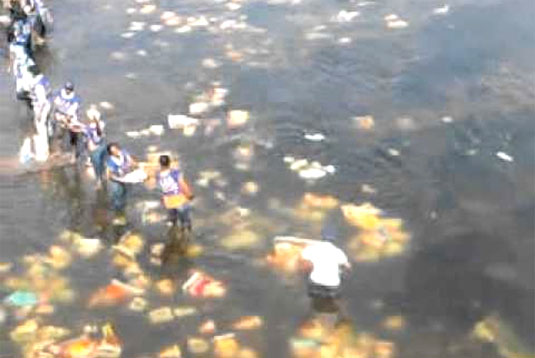
(Image source)
A video of the immersion process in the location shown above can be viewed at the link below.
(Video source)
In the case of rivers, these undissolved idols could block the natural flow of water, causing stagnation and breeding of mosquitoes. The polluted water also causes several diseases including skin diseases. The pollution from Ganesh Chaturthi idols also damages the ecosystem, kills the aquatic life. In many areas, the same polluted water gets pumped into homes!
To avoid this scenario, some people have started using materials like clay, leaves, papier mache, gram flour, puffed rice, fruits and vegetables to make eco-friendly Ganeshas in their homes during the festival. The adults in the family involve the children in such activities so the children learn about the climatic changes and global warming and the need to stop abusing the environment.
Some artists have created Ganeshas using unusual materials like buckets, tumblers, brushes and myriad other tools which are used to clean, even a washing machine! They want to use this festival to drive home the message of “cleanliness in general and in politics in particular” through this form of an artistic Ganesha. Since such Ganeshas are created in the spirit of art they are never immersed and are donated to charities or organisations which use them as art exhibits in institutions.
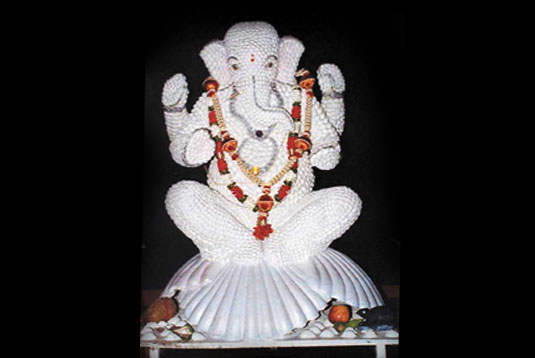
Ganesha idol made out of 10,001 shells. (Image source)
The promotional advertisement for the annual ‘Utsav Moorti Samman’ is shown below. This is a competition for the best Ganesha idols in the Mumbai area conducted by ‘The Times of India’ uses a Ganesha image created from junk and carries the message of recycling to avoid pollution- a call for ecological consciousness.
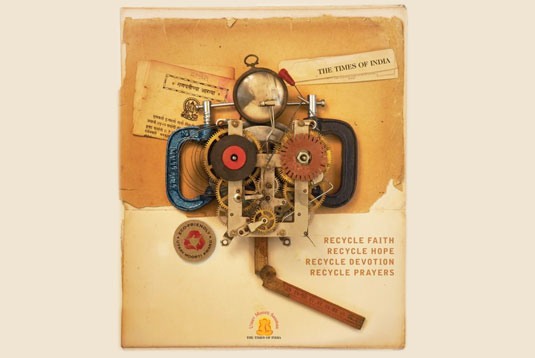
(Image source)
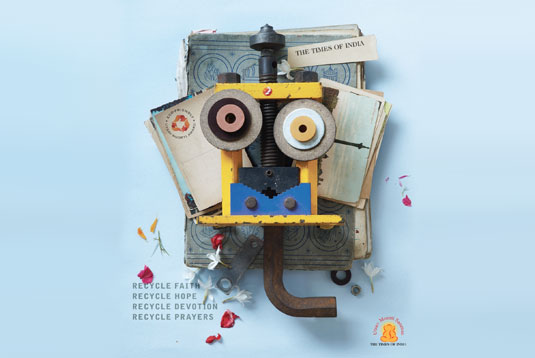
(Image source)
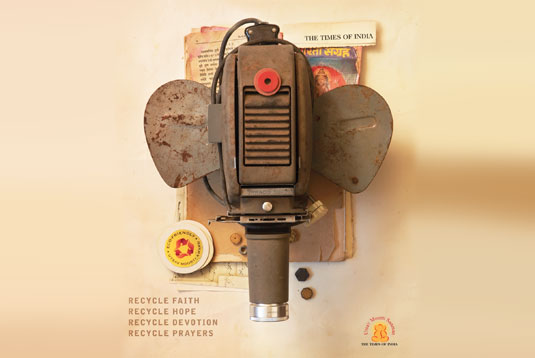
(Image source)
Some people also believe in alternative solutions. Permanent idols made of stone can be used to perform the Ganesh Chaturthi each year along with a symbolic immersion in a bucket of water at home. These can be reused each year which they feel to a large extent fulfils the requirements of the puja process and at the same time is eco-friendly in nature.
Environment friendly idols and practices - Green influence
Trends in creating eco-friendly Ganeshas
Many NGOs that promote environmental awareness and conservation are organising events where people can participate to sculpt Ganesha idols in clay. The need for such events is essential as a lot of people although are interested in greener options, just don’t know where to buy them. These organisations also encourage people to use eco-friendly decorations and recycle the puja flowers. Every year after the Ganesha immersion, volunteers of some NGOs collect and compost the flowers adorning the idols.
Over the past few years an effort is being made by residents of IIT Bombay campus and nearby areas in Powai to take the earth from near their homes, sculpt a Ganesha and return it back to earth by immersing it in a nearby water body, thus ensuring the continuation of the tradition while not degrading the environment.
The soil is manually collected from the Powai lake, cleaned of pebbles and kneaded into fine dough, which is then provided to the workshop participants. Organised by the ‘Save Powai Lake Team’, the project called ‘Navsrujan’ ( a new beginning) was initiated in 2001. This effort has grown in the past 12 years and many workshops were conducted by this group in IIT, and in many schools around Powai to teach children and people to sculpt clay Ganesha idols. These have been used by many who believe in the concept of an eco-friendly Ganeshotsav. Presently Ms. Chaitali Gupta, is the coordinator of the project, from IIT Bombay campus. She has been conducting these workshops with the assistance of many volunteers who also believe in this effort.
The participants of these workshops make their own eco-friendly Ganeshas and take them home to install them for the puja instead of buying plaster of paris idols that have toxic colours that pollute water bodies and endanger aquatic flora and fauna. The workshop is an ongoing effort to save Powai Lake by IIT campus residents and residents of neighbouring areas.
The participation for this workshop has risen to many hundreds over the years which is definitely a positive indication that saving the environment is as an important agenda as performing the Ganesha puja.
Workshop (2013): These workshops were held at the Staff Club, IIT Bombay this year (2013) for three days to accommodate more than 200 participants.
The majority of the participants were children in the 5-12 age group. A few teenagers and adults too participated. The children were accompanied by parents, hence there was an interaction between both while making the Ganesha idol.
The workshop charged a nominal fee from the participants and a ball of clay, and a small plastic sheet to work on was provided.
The participants then sat informally in groups on the floor along with a volunteer who explained the idol making process to them. Usually only small Ganesha idols are encouraged to be made in these workshops.
Over the years a simple step-by-step process has been developed by the workshop organisers to create a clay Ganesha that could be followed easily. Initially the torso, head, legs and hands are built and then the accompaniments like the mouse, Modak, ornamentation and decorations are done.
Natural colours like yellow (using turmeric) and red (using geru or sindoor) are used to decorate the idol. A white paste created out of natural materials like lime and edible gum was used to create the white coloured decorations on the finished Ganesha idol. This was expertly applied by the volunteers on the finished clay idols to add ornamentation and to highlight some details.
The volunteers of the workshop have been trained in this process so they can help and guide the participants to create the idols easily.
The whole idol creation process was very interactive and informal. There was a lot of chattering, exchange of ideas, and individual exploration too. Knowledge and process transfer took place very naturally and at the end of two hours, a small Ganesha idol emerged from the ball of clay along with huge smiles of satisfaction and clay smeared hands and clothes!
The organisers felt that children are the best ambassadors of this eco-friendly venture, as they make sure that their parents use only these clay Ganesha idols for the puja and not the store bought ones.
This workshop thus fulfilled the idea of taking from nature and returning to nature, so that there is perfect balance in our surroundings!
The video link presented below shows excerpts of the workshop that was held at the Staff Club at IIT Bombay this year 2013. (Video source)
Process: The following video captures the step by step creation of a clay Ganesha at the Navsrujan workshop held at IIT Bombay Staff Club in the year 2013. (Video source)
Ms. Vanamala is the volunteer who demonstrates the creation. She has been trained by Ms. Chaitali Gupta and has been with the Navsrujan workshops for the past 8 years. She has a creative background and has been making clay Diyas for Diwali, and is adept at creating Warli paintings too.
Eco-friendly decorations for Ganesha
The Ganesha idol brought home for the Ganesh Chaturthi celebrations is usually installed in a decorated, ornate housing called “makhar” in Mumbai. These were made using thermocole sheets in the past few years. These sheets can be moulded or carved into exquisite decorations. Also these are available in many colourful options too.

A beautiful ‘Makhar’ made of thermocole pieces assembled together with layers of thermocole cutouts in which the Ganesha idol is seated during the puja.
Though these lend a beautiful ornamental touch to the Ganesha idol, disposing them after the Ganesha Visarjan is a problem. Thermocole being a plastic material is not biodegradable and hence becomes an environmental problem. Environmental experts say that Styrofoam component in thermocole causes disposal problems and advises the masses to switch to eco-friendly decorations. Thermocole lingers in the ecosystem for more than 200 years, spreading toxins in the soil and render it infertile. There is also the fear of thermocole installations catching fire, which then release carcinogenic dioxins that cause hormonal imbalances in people.
Some people realising this have tried to recycle these decorations for another year or two by careful storage. Since thermocole sheets are fragile they cannot last beyond a time and eventually they have to be disposed and then again they pose the same environmental hazard.
So, some creative individuals have tried to use alternate materials like recycled paper, newspaper, rice husk fibres. Newspaper is torn into tiny pieces and soaked overnight. It is later rolled into dough with mixing agents, set into earthen moulds and left to dry in sun. These makhars are finished by hand painting them in eco-friendly colours. Though the percentage of usage of such eco-friendly decorations is marginal compared to the plastic ones, if the local civic bodies bring in bans and also if citizens adopt better environment friendly practices then a change can definitely be possible for the better.
- Introduction
- Ganesha - Reverence
- Ganesha Symbology
- Aesthetic Exploration (2D)
- Aesthetic Exploration (3D) Part 1
- Aesthetic Exploration (3D) Part 2
- Ganesha Invocation
- Presence of Ganesha
- Ganesha in Art
- Ganesha in Sculpture
- Ganesha in Literature
- Ganesha in Music
- Ganesha in Telecast Media
- Ganesha Festival
- Video
- Further Links
- Acknowledgements
- Downloads
- Contact details
- Credits














